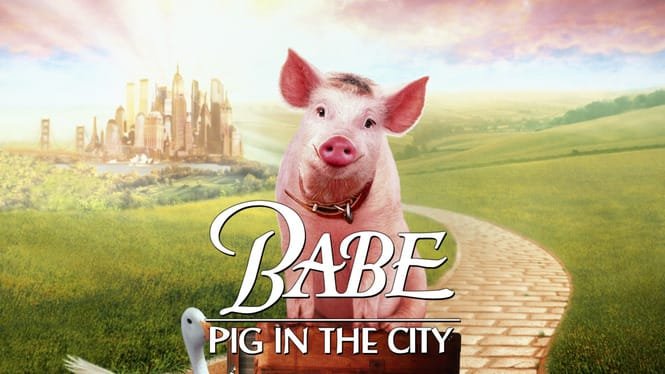
Babe: Pig In The City
The first line of “Babe: Pig in the City” assures us so. And if we talk about heroes, it is even more true for sequels. The original “Babe” was amazing, an Australian family movie that went unrecognized until it was embraced and loved and nominated for a best picture Oscar. Can the sequel match this? It can, it does, it may even be more magical than the first one in many ways.
In “Babe” (1995) everything leads up to the big sheepherding contest, where the pig who works like a dog turns out to be the best sheep-pig of them all. But “Babe: Pig in the City” isn’t as plot-bound; although there are plenty of villains, chases and close calls required by such plots. It’s more of a wonderment lolling along with its delightful images that are original and funny.
It doesn’t make any mistakes it could have made. It doesn’t put too much emphasis on human characters instead it puts less emphasis on them and has more animals on the screen. It doesn’t recycle the first story instead it introduces lots of new characters. It outdoes itself with sets and special effects that create “the city.” And it’s still literate, humane and wickedly funny George Miller, who produced, directed and co-wrote both films (based on Dick King Smith’s books), has taken ideas from “Babe” but instead of copying them he’s improved on them and spun them off into new dimensions in “Pig in the City.”
The movie opens with Babe returning to Hoggett’s farm in triumph with his sheep dog trophy. Alas, he falls down a well; this sets off a calamitous chain of events which ends with Farmer Hoggett (James Cromwell) laid up in bed sick as a pig while Mrs. Hoggett (Magda Szubanski) has to exhibit Babe at a state fair to save the farm from foreclosure. Alas again, she and Babe miss their connecting flight (she is busted on suspicion of drug possession that merry apple-cheeked dumpling of a lady). And they are homeless in the cruel city, where, we all know, no hotels will let you stay if you’re a pig.
What a city it is! I love imaginary cities in the movies, from “Metropolis” (1926) to “Dark City,” and here’s one to set beside them. Using elaborate sets that surround the buildings with canals, Miller creates a skyline through special effects which impudently incorporates such landmarks as the Statue of Liberty, the Sydney Opera House and the Hollywood sign. It’s all cities. And in this city Babe finds himself at a boarding house whose landlady (Mary Stein) believes that animals deserve rooms just like people do.
There is an extensive cast of animal characters; their dialogue is dubbed and they are colorful and unique not just silly talking animals. One of my favorite scenes takes place when Ferdinand the duck (voice character Danny Mann) tries to keep up with the jet that is taking Babe to the city: The shot of him flapping in a rear view, going full tilt, is one of the funniest moments in the movie. (He eventually gets a lift from a pelican: “Go well, noble duck!”) In the boarding house, we meet chimpanzees, cats, fish and a dog who’s paralyzed below the waist and moves around on wheels.
Tricked by some of his new housemates into diverting fierce dogs during a desperate food raid; seemingly facing doom, he turns, looks his enemy in the eye and asks, “Why?” He has a close call with a bull terrier (voice character Stanley Ralph Ross doing Chicago gangster), which tries to kill him and ends up hanging by its teeth in the canal. Babe saves it from drowning; it becomes his fierce protector: “What the pig says goes!” Wonders large and small fill this movie: little gags at the side of the frame and big laughs right down the center.
It’s far from being just a “children’s movie,” but rather one that expands everyone’s imagination about what movies can do there’s something very grown-up about its narration, its characters’ attitudes toward life and much of what happens. (Some other things that happen are cheerfully goofy as when Mrs. Hoggett finds herself in some sort of weird bungee like chandelier-swinging episode.) This movie doesn’t include or refer to anything outside itself no celebrities voicing characters or pop songs for marketing tie-ins; everything springs directly out of pure filmmaking imagination: Pure invention.
The world and its inhabitants all come straight out of thin air, and in their impossibility they seem more real than the characters in many movies taken from “real life.” They are utterly human; their hearts are absolutely in the right places. And beyond what they do or say, there is simply the delight of the world they live in (“A place just to the left of the 20th century”). I loved “Babe” for all those reasons we generally love great movies, but I love “Babe: Pig in the City” even more not for any of those usual reasons, because this movie doesn’t have anything that would count as a usual reason.
Watch Babe: Pig In The City For Free On Gomovies.
.jpg?w=1024&resize=1024,1024&ssl=1)
.jpg?w=1024&resize=1024,1024&ssl=1)
.jpg?w=1024&resize=1024,1024&ssl=1)
.jpg?w=1024&resize=1024,1024&ssl=1)
.webp?w=1024&resize=1024,1024&ssl=1)
.jpg?w=1024&resize=1024,1024&ssl=1)
.jpg?w=1024&resize=1024,1024&ssl=1)
.jpg?w=1024&resize=1024,1024&ssl=1)